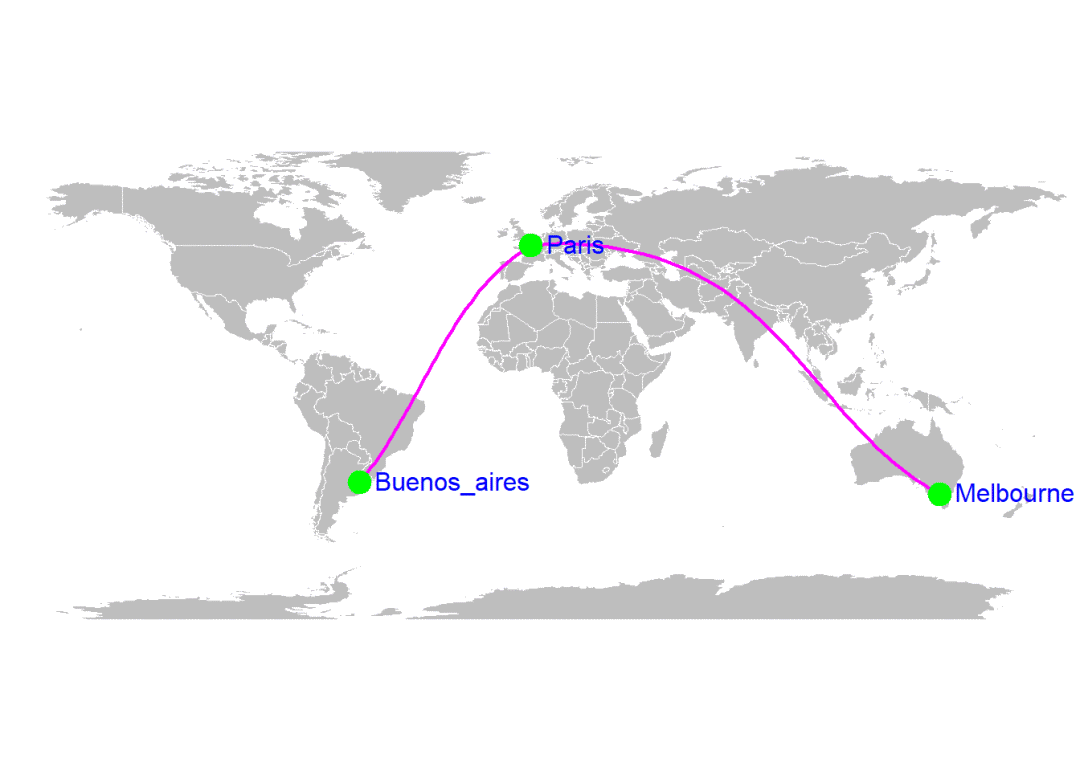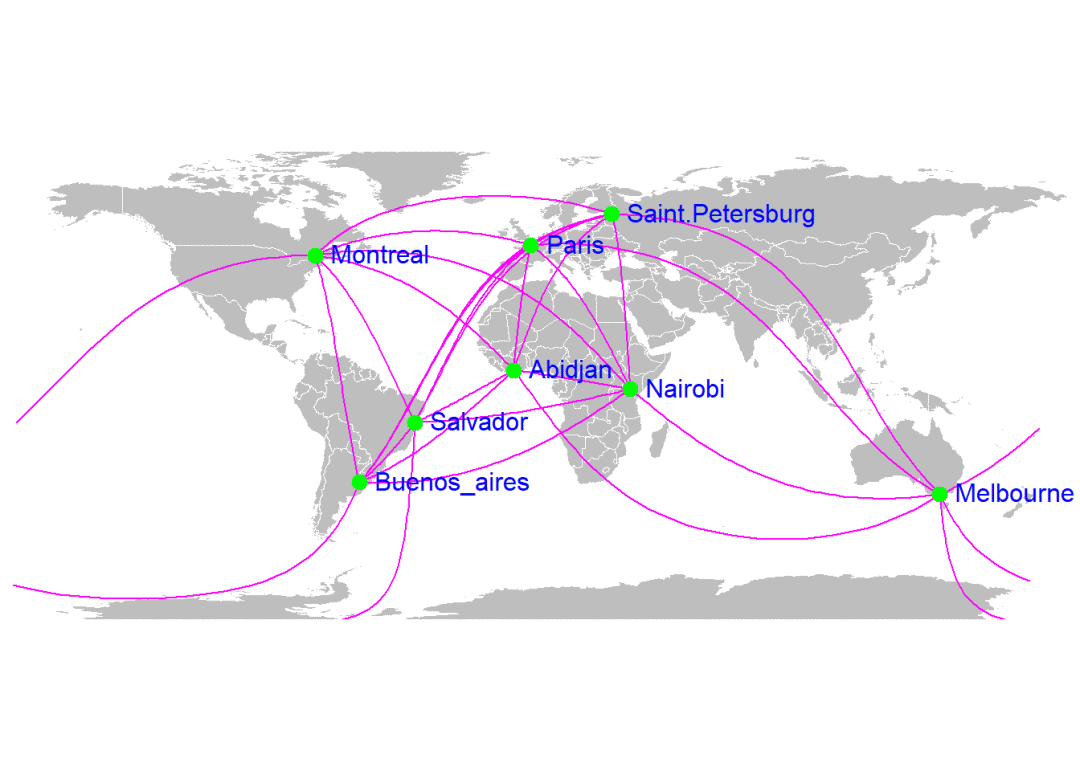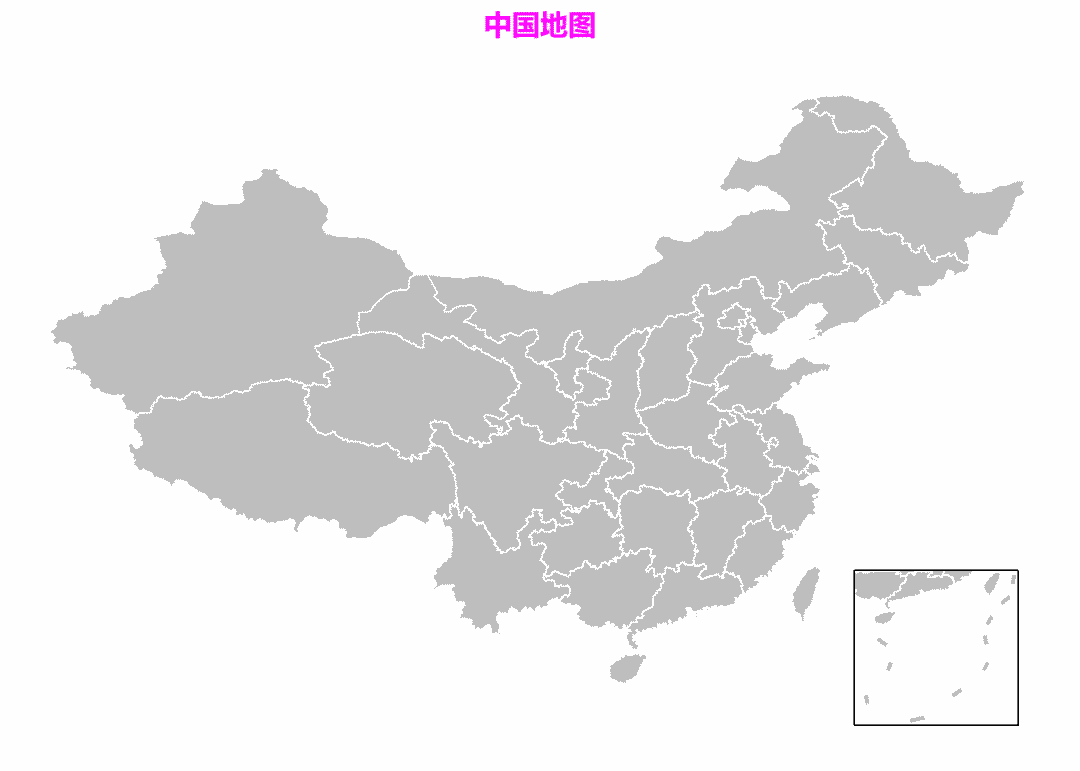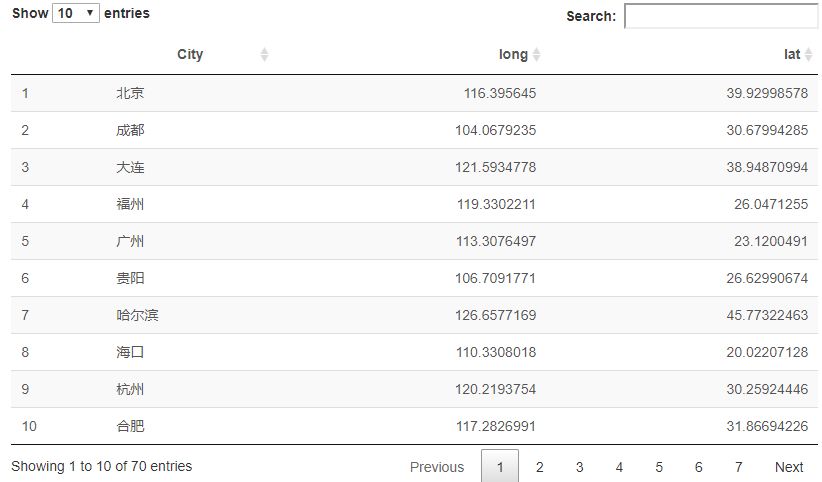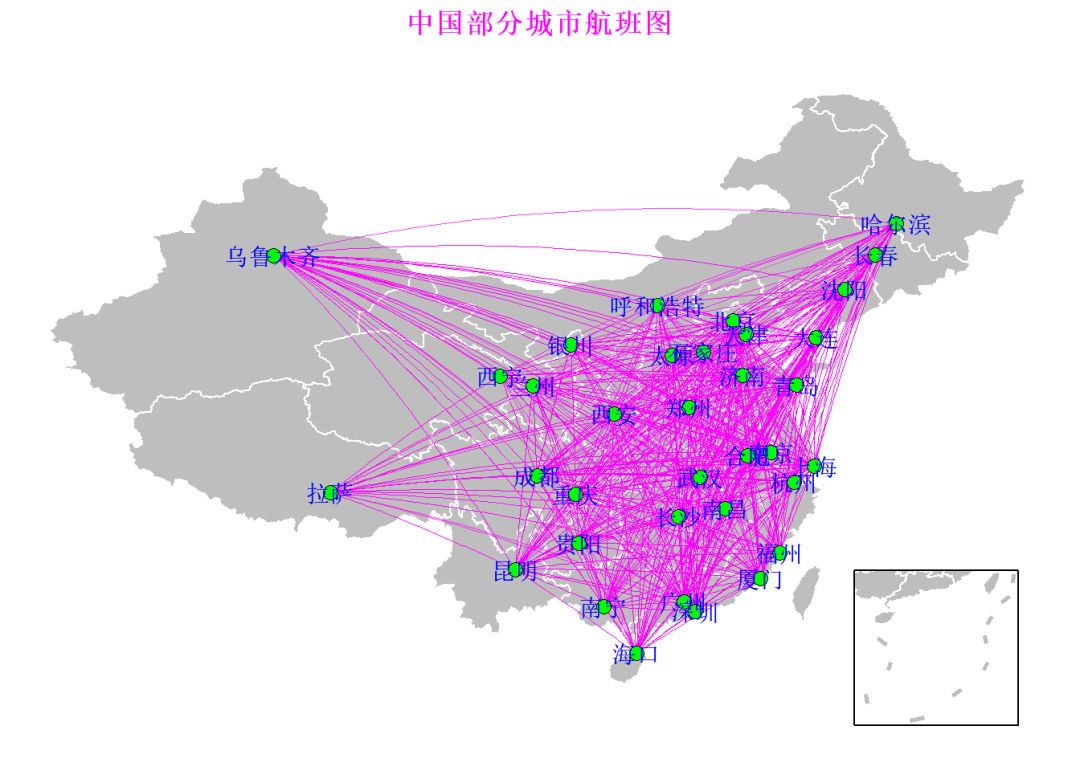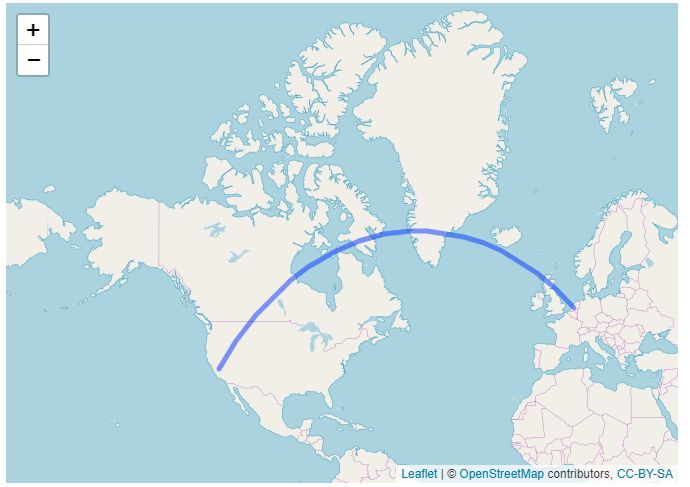gcIntermediate_航线图_必知必会
作者:李誉辉
四川大学在读研究生
简介
航线图,本质上是一种曲线,根据地理学知识,我们知道:
地球表面任意两点之间的最短距离等于:
过这两点,以地心为圆心,地球半径为半径的圆弧长度。
且这条圆弧是唯一的,只要知道圆弧2个端点的坐标,就能求出圆弧的方程,
由于圆弧的方程比较复杂,且端点改变,则方程也会相应发生变化,对于绘图不太方便。
所以只要求出圆弧上若干点的坐标,
然后使用base::lines()或ggplot2::geom_line()就能绘制曲线。
在leaflet中采用addPolylines()同样也能添加航线图。
所以关键在于求出2点构成的圆弧上若干点的坐标,
好在已经有封装好的函数了,这就是我们今天介绍的gcIntermediate()函数。
其来自geosphere包。
语法:
gcIntermediate(p1,p2,n=50,breakAtDateLine=FALSE,addStartEnd=FALSE,sp=FALSE,sepNA)
参数解释:
p1,表示起点坐标,可以用长度为2的数字向量指定,分别为经度/纬度。
也可以用2列数字矩阵指定,第1列为经度,第2列为纬度。
还可以用SpatialPoints对象指定。p2,表示终点坐标,用法与p1一致。n, 表示生成中间点的数量。breakAtDateLine, 为逻辑值,表示如果圆弧跨过了国际日期变更线时,是否返回2个矩阵。addStartEnd, 为逻辑值,表示返回的数据是否包括端点,TRUE则返回n + 2个。sp, 为逻辑值,表示是否返回SpatialLines对象。这在用tmap包绘图时非常方便。sepNA, 为逻辑值,表示当p1为多个点坐标时,是返回列表,
还是返回2列的矩阵,该矩阵中,使用NA行作为分割符,使各个圆弧之间的数据分开。
1library(geosphere)
2
3# 计算2点之间的中间点坐标
4line_points_1 <- gcIntermediate(c(168,-50), c(168,90), n = 5, addStartEnd = TRUE)
5class(line_points_1);
6line_points_1 # 返回5个中间点,2个端点,共7个点坐标
7
8# 多组点之间的中间点坐标
9start_points <- rbind(c(168,-50), c(5,52))
10end_points <- rbind(c(168,90), c(20,52))
11line_points_2 <- gcIntermediate(start_points, end_points, n = 5, addStartEnd = TRUE)
12class(line_points_2) # 默认返回list
13line_points_2[[1]]; line_points_2[[2]] # 索引出来
14rm(start_points, end_points, line_points_1, line_points_2)
1## [1] "matrix"
2## lon lat
3## [1,] 168 -50.000000
4## [2,] 168 -26.666667
5## [3,] 168 -3.333333
6## [4,] 168 20.000000
7## [5,] 168 43.333333
8## [6,] 168 66.666667
9## [7,] 168 90.000000
10## [1] "list"
11## lon lat
12## [1,] 168 -50.000000
13## [2,] 168 -26.666667
14## [3,] 168 -3.333333
15## [4,] 168 20.000000
16## [5,] 168 43.333333
17## [6,] 168 66.666667
18## [7,] 168 90.000000
19## lon lat
20## [1,] 5.000000 52.00000
21## [2,] 7.490089 52.13235
22## [3,] 9.992050 52.21199
23## [4,] 12.500000 52.23858
24## [5,] 15.007950 52.21199
25## [6,] 17.509911 52.13235
26## [7,] 20.000000 52.00000
1.1
单条曲线
1library(tidyverse)
2library(maps)
3library(geosphere)
4
5par(mar = c(0,0,0,0)) # 边距全部为0
6
7# 坐标点
8Buenos_aires <- c(-58,-34) # 布宜诺斯艾利斯
9Paris <- c(2,49) # 巴黎
10Melbourne <- c(145,-38) # 墨尔本
11points_data <- rbind(Buenos_aires, Paris, Melbourne) %>% as.data.frame()
12colnames(points_data) <- c("long","lat")
13
14# 计算中间点坐标
15inter_points_1 <- gcIntermediate(Paris, Buenos_aires, n = 50, addStartEnd = TRUE)
16inter_points_2 <- gcIntermediate(Melbourne, Paris, n = 50, addStartEnd = TRUE)
17
18# 画图
19## 地图底层
20map('world', col = "grey", fill = TRUE, bg = "white",
21 lwd = 0.05, mar = rep(0,4), border = 0, ylim = c(-80, 80))
22# 叠加曲线
23lines(inter_points_1, col = "magenta", lwd = 2) # 从巴黎到布宜诺斯艾利斯
24lines(inter_points_2, col = "magenta", lwd = 2) # 从墨尔本到巴黎
25## 叠加点
26points(x = points_data$long, y = points_data$lat,
27 col = "green", cex = 3, pch = 20)
28## 叠加文字
29text(x = points_data$long, y = points_data$lat,
30 labels = rownames(points_data), col = "blue", cex = 1, pos = 4)
1.2
多条曲线
1library(magrittr)
2library(tidyverse)
3library(maps)
4library(geosphere)
5
6# 因为这里我们要绘制许多条曲线,不妨新建一个绘制曲线的函数,
7## 用于绘制经过多个点的一条曲线。
8plot_connection <- function(lon_1, lat_1, lon_2, lat_2, ...) {
9 inter_points <- gcIntermediate(c(lon_1, lat_1), c(lon_2, lat_2),
10 n = 50, addStartEnd = TRUE)
11
12 inter_points <- data.frame(inter_points)
13 lon_diff <- abs(lon_1) + abs(lon_2)
14 # 因为地图底层中中间是0度经线
15 ## 若经度绝对值之和大于180,则分成2条曲线画,反之直接画一条曲线,
16 if(lon_diff > 180) {
17 lines(subset(inter_points, lon >= 0), ...)
18 lines(subset(inter_points, lon < 0), ...)
19 } else {
20 lines(inter_points, ...)
21 }
22}
23
24# 数据点坐标
25points_data <- rbind(
26 Buenos_aires = c(-58,-34), # 布宜诺斯艾利斯
27 Paris = c(2,49), # 巴黎
28 Melbourne = c(145,-38), # 墨尔本
29 Saint.Petersburg = c(30.32, 59.93),# 圣彼得堡
30 Abidjan = c(-4.03, 5.33), # 阿比让
31 Montreal = c(-73.57, 45.52),# 蒙特利尔
32 Nairobi = c(36.82, -1.29), # 内罗毕
33 Salvador = c(-38.5, -12.97) # 萨尔瓦多
34 ) %>%
35 as.data.frame()
36colnames(points_data) <- c("long","lat")
37
38# 排列组合,任意2个点之间的排列组合
39all_pairs <- cbind(t(combn(points_data$long, 2)),
40 t(combn(points_data$lat, 2))) %>%
41 as.data.frame()
42colnames(all_pairs) <- c("long1", "long2", "lat1", "lat2")
43
44# 地图底层
45par(mar = c(0,0,0,0))
46map('world', col = "grey", fill = TRUE, bg = "white", lwd = 0.05,
47 mar = rep(0,4), border = 0, ylim = c(-80, 80))
48
49# 调动函数绘制曲线
50for(i in 1:nrow(all_pairs)) {
51 plot_connection(all_pairs$long1[i], all_pairs$lat1[i],
52 all_pairs$long2[i], all_pairs$lat2[i],
53 col = "magenta", lwd = 1)
54}
55
56# 增加点和文字
57points(x = points_data$long, y = points_data$lat,
58 col = "green", cex = 2, pch = 20)
59text(x = points_data$long, y = points_data$lat,
60 labels = rownames(points_data),
61 col = "blue", cex = 1, pos = 4)
2.1
地图数据
1library(ggplot2)
2library(readr)
3library(showtext)
4
5# 更改字体
6windowsFonts(YaHei_rontine = windowsFont("微软雅黑"),
7 Time_NewR = windowsFont("Times New Romans 常规"))
8font_add("YaHei_rontine", regular = "msyh.ttc", bold = "msyhbd.ttc")
9
10# 读取地图数据
11path_part_1 <- "E:/R_input_output/data_output/rds_documents/"
12Chinamap_with_mini <-
13 read_rds(path = paste0(path_part_1, "Chinamap_with_mini.rds"))
14Nine_lines_mini <-
15 read_rds(path = paste0(path_part_1, "Nine_lines_mini.rds"))
16rect_data <-
17 read_rds(path = paste0(path_part_1, "rect_data.rds"))
18
19# 绘图
20showtext_auto()
21ggplot() +
22 geom_polygon(data = Chinamap_with_mini,
23 aes(x = long, y = lat, group = interaction(class, group)),
24 fill = "grey", colour = "white", size = 0.5) +
25 # 增加小地图边框
26 geom_rect(aes(xmin = rect_data[2], xmax = rect_data[2] + rect_data[8] + 0.3,
27 ymin = rect_data[1] - 0.3, ymax = rect_data[1] + rect_data[7]),
28 fill = NA, colour = "black", size = 0.5) +
29 # 在小地图上增加南海九段线
30 geom_line(data = Nine_lines_mini,
31 aes(x = long, y = lat, group = ID),
32 colour = "grey", size = 1) +
33 ylim(15,55) +
34 labs(title = "中国地图") +
35 theme_void() +
36 theme(plot.title = element_text(
37 family = "YaHei_rontine", face = "bold",
38 colour = "magenta", hjust = 0.5),
39 panel.background = element_rect(fill = "white"),
40 panel.grid = element_blank())
41
42map_China <- ggplot() +
43 geom_polygon(data = Chinamap_with_mini,
44 aes(x = long, y = lat, group = interaction(class, group)),
45 fill = "grey", colour = "white", size = 0.5) +
46 # 增加小地图边框
47 geom_rect(aes(xmin = rect_data[2], xmax = rect_data[2] + rect_data[8] + 0.3,
48 ymin = rect_data[1] - 0.3, ymax = rect_data[1] + rect_data[7]),
49 fill = NA, colour = "black", size = 0.5) +
50 # 在小地图上增加南海九段线
51 geom_line(data = Nine_lines_mini,
52 aes(x = long, y = lat, group = ID),
53 colour = "grey", size = 1)
54
2.2
航班数据
1library(readr)
2library(magrittr)
3library(dplyr)
4library(geosphere)
5
6# 读取数据
7airlines_CN <- read_csv(file = "E:/R_input_output/data_input/航班/国内航班数据new.csv",
8 locale = locale(encoding = "GBk")) # GBK避免中文乱码
9
10important_cities <- read_csv(file = "E:/R_input_output/data_input/important_cities_CN.csv",
11 locale = locale(encoding = "GBk")) # GBK避免中文乱码
12
13# 因为数据太大,只筛选重点城市(包括省会)之间的航班数据
14airlines_CN %<>% filter(Start_City %in% important_cities$City) %>%
15 filter(End_City %in% important_cities$City)
16
17# 筛选出机场坐标
18airports_CN_1 <- select(airlines_CN, Start_City, Start_long, Start_lat) %>%
19 group_by(Start_City) %>% slice(1) %>%
20 dplyr::rename(City = Start_City, long = Start_long, lat = Start_lat)
21
22airports_CN_2 <- select(airlines_CN, End_City, End_long, End_lat) %>%
23 group_by(End_City) %>% slice(1) %>%
24 dplyr::rename(City = End_City, long = End_long, lat = End_lat)
25
26airports_CN <- rbind(airports_CN_1, airports_CN_2)
27rm(airports_CN_1, airports_CN_2)
28
29# 计算中间点数据
30inter_points_data <- gcIntermediate(p1 = select(airlines_CN, Start_long, Start_lat),
31 p2 = select(airlines_CN, End_long, End_lat),
32 n = 50, addStartEnd = TRUE, sepNA = TRUE)
33inter_points_data %<>% as.data.frame()
34inter_points_data$group <- rep(1:nrow(airlines_CN), each = 50 + 3) %>%
35 .[-length(.)] # 移除最后一位,因为最后一位不是NA
36
37head(airlines_CN)
38DT::datatable(airports_CN)
39head(inter_points_data)
(实际效果可交互)
2.3
绘制航线图
1library(ggplot2)
2
3showtext_auto()
4map_China +
5 geom_line(data = inter_points_data,
6 aes(x = lon, y = lat, group = group),
7 color = "magenta", size = 0.25, alpha = 0.5) +
8 geom_point(data = airports_CN,
9 aes(x = long, y = lat),
10 shape = 21, fill = "green", size = 3) +
11 geom_text(data = airports_CN,
12 aes(x = long, y = lat, label = City),
13 color = "blue", family = "YaHei_rontine") +
14 ylim(15,55) +
15 labs(title = "中国部分城市航班图") +
16 theme_void() +
17 theme(plot.title = element_text(
18 family = "YaHei_rontine", face = "bold",
19 colour = "magenta", hjust = 0.5),
20 panel.background = element_rect(fill = "white"),
21 panel.grid = element_blank())
对leaflet不熟悉的可以参考 R_leaflet包_最易上手地图教程(二)
1library(leaflet)
2library(geosphere)
3
4gcIntermediate(c(5,52), c(-120,37),
5 n = 100,
6 addStartEnd = TRUE,
7 sp = TRUE) %>%
8leaflet() %>%
9addTiles() %>%
10addPolylines()
tmap包支持sf和sp对象,这里我们直接使用geIntermediate生成sp对象。
4.1
数据处理
1library(sp)
2library(readr)
3library(dplyr)
4
5# 计算中间点数据
6inter_points_sp <- gcIntermediate(p1 = select(airlines_CN, Start_long, Start_lat),
7 p2 = select(airlines_CN, End_long, End_lat),
8 n = 50, addStartEnd = TRUE, sp = TRUE)
9proj4string(inter_points_sp) <- CRS("+proj=aea +lat_1=25 +lat_2=50 +lon_0=105")
10
11# 读取中国省级地图数据
12path_part_1 <- "E:/R_input_output/data_output/rds_documents/"
13Chinaprovinces_sp <-
14 read_rds(path = paste0(path_part_1, "Chinaprovinces_sp.rds"))
15# 读取南海九段线地图数据
16Nine_lines_sp <-
17 read_rds(path = paste0(path_part_1, "Nine_lines_sp.rds"))
18# 将机场数据转化为sp对象
19airports_CN_sp <- SpatialPointsDataFrame(coords = cbind(x = airports_CN$long,
20 y = airports_CN$lat),
21 data = dplyr::select(airports_CN, City),
22 proj4string =
23 CRS("+proj=aea +lat_1=25 +lat_2=50 +lon_0=105"))
24
4.2
绘图
1library(tmap)
2
3showtext_auto()
4tm_shape(shp = Chinaprovinces_sp) +
5 tm_polygons(col = "grey", border.col = "white") +
6 tm_shape(shp = Nine_lines_sp) +
7 tm_lines(col = "grey", lwd = 2) +
8 tm_shape(shp = inter_points_sp) +
9 tm_lines(col = "magenta", lwd = 0.25, alpha = 0.5) +
10 tm_shape(shp = airports_CN_sp) +
11 tm_dots(col = "green", size = 1, shape = 21) +
12 tm_text(text = "City", fontfamily = "YaHei_rontine", col = "blue") +
13 tm_layout(title = "中国部分城市航班图",
14 title.size = 2, title.color = "red",
15 title.fontfamily = "YaHei_rontine")
参
考来源
Leaflet航线图
https://stackoverflow.com/questions/34499212/adding-curved-flight-path-using-rs-leaflet-package
Drawing curved lines between points in ggmap
https://stackoverflow.com/questions/23601678/drawing-curved-lines-between-points-in-ggmap
How to draw connecting routes on map with R and great circles
https://www.r-bloggers.com/how-to-draw-connecting-routes-on-map-with-r-and-great-circles/
DRAW CURVED LINES ON A MAP!
https://dataviz.love/2017/02/13/draw-curved-lines-map/
geom_line
https://ggplot2.tidyverse.org/reference/geom_path.html
Welcome to Mapping with R
http://clarkdatalabs.github.io/mapping_R/
gcIntermediate函数
https://rdrr.io/cran/geosphere/src/R/gcIntermediate.R
国际日期变更线的意义
https://www.zhihu.com/question/27910343
——————————————
往期精彩:

